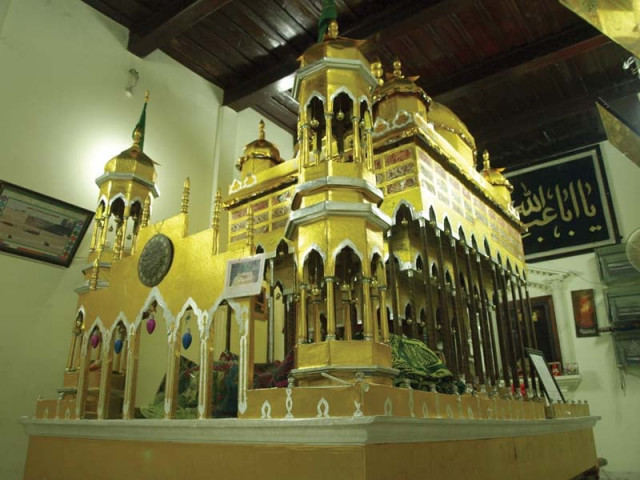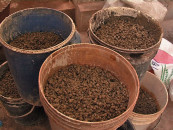Preserving history: The flourishing custom of mourning through tazias
Replicas of Imam Hussain’s (RA) shrine in Hyderabad are made for those unable to visit Karbala

This was built in 1872-75 by Mir Hassan Ali Khan Talpur. It is placed in Karbala imambargah in Latifabad Unit 4, near the 19th century Talpur Haveli. PHOTOS: EXPRESS
In Hyderabad, some of these customs originated and evolved from earlier centuries or were promoted mainly from the later part of the 18th century when the Talpur dynasty took the reins from the Kalhoro dynasty. Some others were introduced much later by migrants from India after Partition.
Among the several historic customs is the tradition of making wooden miniature shrines, popularly known as tazia in the Subcontinent, of Hazrat Imam Hussain's (RA) shrine in Karbala. Their height ranges from a few feet to over a dozen feet and most weigh in tens to hundreds of kilogrammes while others, in a ton or more.
The commonly known reason for making this type of replica is to provide ziarat [sight] of the shrine to the people who cannot travel to Karbala, Iraq to pay their respects.
The 14-century Turco-Mongol conqueror Timur Lane is credited for introducing the tazia-making that evolved in the following centuries from immovable mud miniatures to movable mud, wood, metal and cardboard tazias.

The trend, started by the Talpurs in Sindh from Hyderabad, continues to flourish with more than a 100 wooden tazias being taken out presently either in processions or as displays for ziarat in different parts of the city.
Among them, two were built by the Talpurs during the late 18th and 19th centuries. The origin of at least four others can also be traced to late 19th or early 20th centuries. All of them continue to exist in their original structures thanks to their safekeeping as sacred objects in separate imambargahs.
Historical anatomy
According to Sattar Dars, an author who has written profusely on the history of observing Muharram and ways of mourning and other subjects, tazias were also made during the Samma dynasty (1351-1524) and the preceding Soomro dynasty. "They made tazias with mud in Muharram. After the annual rituals, those tazias were either drowned in the river or buried in an imambargah," he told The Express Tribune.
However, Dars credits the Talpurs, starting from the first ruler, Mir Fateh Ali Khan Talpur, who was enthroned in 1783, for institutionalising the observance of Muharram.

This was built in the late 18th century by Mir Fateh Ali Khan Talpur, first ruler of Talpur dynasty. It was placed for seven to eight decades at Faqir Jo Pirh in downtown Hyderabad. In the 1870s, Mir Noor Muhammad Khan Talpur handed over this tazia to the Mirza family. Since then, it is placed in Aliabad imambargah in Tando Agha, Hyderabad. PHOTO: COURTESY SATTAR DARS
"A stone carrying the footprints of Hazrat Ali (RA) was given as a gift by Iran's king Fateh Ali Shah Kachaar to the Talpur king, Mir Ghulam Ali Talpur and the Talpurs then built a Qadam Gah [in Hyderabad]," shared Dars, adding that they [Talpurs] set up pirhs [a place where mourning processions gather], imambargahs, long wooden alams [a remembrance of the standard carried by Hazrat Abbas (RA)] and tazia. In their darbar, the poets recited marsia [elegy], making the mourning an official event every year, he said.
Old miniature shrines
In the late 18th century, Mir Fateh tasked his general, Fakeer Muhammad Junejo, to establish a pirh - which exists till this day with the name of Fakeer Jo Pirh in downtown Hyderabad - at a few hundred metres from the Puqqa Qila Fort.
It was here that the oldest existing tazia was first placed for ziarat, more than two centuries ago, reveals Mir Haider Ali Talpur, a descendant of the Talpurs, who looks after the 19th century Talpur Haveli in Latifabad. According to Mir Haider, his forefather, Mir Noor Muhammad Khan Talpur, handed over the tazia to the Mirza family.
"Our ancestors were given custody of this tazia in the late 18th century. It was then shifted to our imambargah Aliabad in Tando Agha," said Hyderabad colleges director Mirza Imam Ali, who heads the family.
Citing anecdotes from his predecessors, he said that in the two to three decades following the occupation of Sindh by the British in 1843, the tazia faced decay. "The Talpurs were sent to jail in Calcutta and the tazia no longer received the regal care which it used to get in its over first five decades of existence."
The British imprisoned 11 people of the Talpur family, among them the last ruler, Mir Naseer Khan Talpur and the princes. Mir Haider said that seven of them died in Calcutta, while four were freed. Among them, Mir Hassan Ali Khan Talpur, Mir Naseer's son, and Mir Hussain Ali Khan Talpur, the king's nephew, were freed in 1863 and 1858, respectively.

This was built in the 1920s and placed in the premises of the shrine of Ashraf Ali Shah Bukhari adjacent to Puqqa Qila. This tazia became popular because of an Englishman, Charlie Ellicot. Ellicot, son of Dr Lady Dufferin, converted to Islam. He organised mourning processions and majalis in Muharram and looked after the shrine till his death in 1969. He is buried at the same shrine.
It was Mir Hassan who built the second oldest tazia of Hyderabad between 1872 and 1875. It was placed at an imambargah near the Talpur Haveli in village Tando Noor Muhammad, close to Giddu Bunder on River Indus, located in present day Latifabad Unit 4.
"For the first eight to 10 years, the tazia procession used to be taken out from this village all the way to the Puqqa Qila [around four kilometres away] on Muharram 10. The route was later changed and the movement was restricted to a closer proximity," recalled Mir Haider.
Mir Mohsin Talpur, who looks after the imambargah Karbala and the tazia, said that 10 to 12 people are required to carry the miniature shrine. "Its wooden structure is so strong that we believe it can survive for the next five to six decades. We just replace its paper foil every two to three years, aside from carrying out other maintenance work," said Mir Mohsin.
Another tazia, almost a century-old, won popularity in the city because of an Englishman, Charlie Ellicot. The son of a doctor, Lady Elizabeth Dufferin, Ellicot was attached to the shrine of Syed Ashraf Ali Shah Bokhari, located adjacent to Puqqa Qila Fort, since his childhood. He converted to Islam, changed his name to Ali Gohar and took responsibility of the shrine as well as the pirh in 1938. The pirh was later renamed as Ellicot Jo Pirh. He died in 1969 at the age of 71 and was buried at the shrine's premises.
Interestingly, despite the significance of their heritage, none of these tazias are officially declared heritage items.
Published in The Express Tribune, October 12th, 2016.



















COMMENTS
Comments are moderated and generally will be posted if they are on-topic and not abusive.
For more information, please see our Comments FAQ